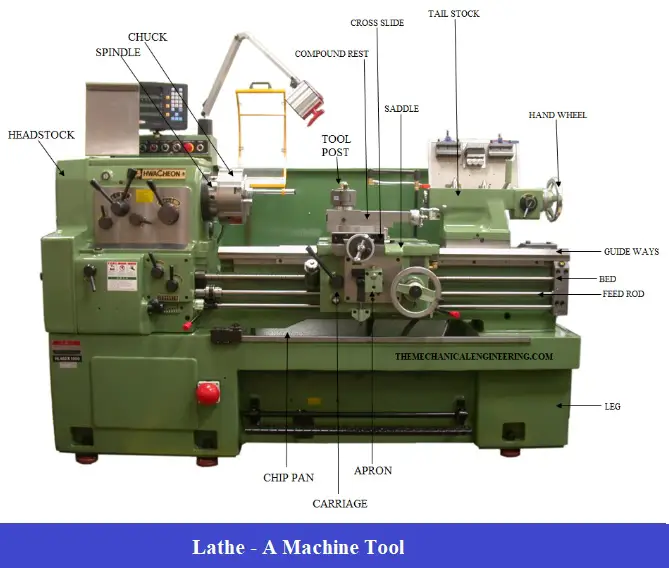A lathe is a machine tool that performs various tasks such as cutting, sanding, knurling, drilling, deformation, facing.

It eliminates the unwanted material from a rotating workpiece in the form of chips with the assistance of a tool that is traversed across the work and can be fed deep into the work.
Table of Contents
Parts of Lathe Machine:
- Bed
- Headstock
- Tail Stock
- Carriage
- Saddle
- Cross Slide
- Compound rest
- Tool Post
- Apron
- Chuck
- Feed rod
- Lead Screw
Now we will discuss parts of the lathe machine in brief:
Bed
The bed of the machine is the base on which the wide range of various pieces of the machine is mounted. The bed is produced using Cast iron or nickel cast iron combination and is upheld on broad box-area segments.
Headstock
The headstock is fixed on the left side of the bed. The headstock is used to transmit the power to the various parts of the lathe.
Tail Stock
The tailstock is a mobile projecting situated inverse the headstock in transit of the bed. The fundamental capacity of the tailstock is to help the other end of the work when being machined. To hold an apparatus for performing activities like penetrating, reaming, tapping, and so on
It comprises the dead habitats, the changing screws, and the handwheel. The body of the tailstock is customizable on the base which is mounted on the guideways of the bed and can be moved.
Carriage
Carriage is situated among headstock and tailstock. The essential capacity of the carriage is to help, guide, and feed the apparatus against the work during activity.
Saddle
The saddle is an H-molded projecting mounted on the highest point of the machine ways. It offers help to cross-slide, compound rest, and apparatus posts.
Cross Slide
Cross slide is furnished with a female dovetail on one side and gathered on the highest point of the seat with its male dovetail. The top surface of the cross slide is furnished with T openings to empower the fixing of the back instrument post or coolant connection. Carriage essentially gives a mounted or programmed cross-development for the cutting apparatus.
Compound rest
Compound rest is present on the highest point of the cross slide. It supports the tool post and cutting instrument in its different positions. Compound rest is essential for turning angles and boring short tapers and forms on forming tools.
Tool Post
The tool post is mounted on the compound rest. It is utilized to hold different cutting apparatus holders. The holders lay on a wedge that is molded on the base to find a way into an inward formed ring.
Which allows the tallness of the forefront to be changed by shifting the apparatus. It is fixed on the top slide. It gets its development by the development of the seat, cross slide, and top slide.
Apron
The Apron is affixed to the seat and looms over the front of the bed. The cover comprises of the pinion wheels and grasps for sending movement from the feed bar to the carriage, and the split nut which draws in with the lead screw during cutting strings.
Chuck
A throw is essentially used to hold the workpiece, especially of short length and huge breadth or of unpredictable shape which can’t be helpfully mounted between focuses. It tends to be connected to the machine by screwing on the axle nose.
Feed rod
The feed pole is a force transmission instrument utilized for the exact straight development of the carriage along with the longitudinal hub of the machine. In some machine machines rather than feed poles lead screws are utilized.
Lead Screw
The lead screw is utilized generally for the situation when the stringing activity is to be performed on a machine. As we probably are aware stringing activity requires rotational development of the work (workpiece) and the straight development of the apparatus.
Types of Lathe Machine:
- Engine Lathe or Center Lathe
- Speed Lathe
- Turret lathe
- Capstan Lathe
- Toolroom Lathe
- Bench Lathe
- Gap bed lathe
- Hollow spindle Lathe
- Vertical Turret Lathe and
- CNC Lathe Machine.
Operation Performed By Lathe Machine:
- Turning Operation
- Tapered Turning
- Shoulder Turning
- Facing Operation
- Thread cutting operation
- Parting Operation
- Chamfering Operation
- Knurling Operation
- Drilling Operation
- Boring Operation
- Counter Boring Operation
- Countersinking Operation and
- Reaming Operation
Advantages:
- It gives high-quality products.
- The speed of the lathe machine is very fast.
- It is cost-effective.
- It saves time.
